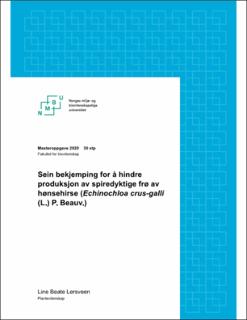| dc.contributor.advisor | Brandsæter, Lars Olav | |
| dc.contributor.advisor | Tørresen, Kirsten | |
| dc.contributor.author | Lersveen, Line Beate | |
| dc.date.accessioned | 2020-10-15T09:10:01Z | |
| dc.date.available | 2020-10-15T09:10:01Z | |
| dc.date.issued | 2020 | |
| dc.identifier.uri | https://hdl.handle.net/11250/2682998 | |
| dc.description.abstract | Hønsehirse (Echinochloa crus-galli) som ofte blir ofte omtalt som verdens tredje verste ugras, sprer seg i områdene rundt Oslofjorden. Hønsehirse blir sett på som et økende problem i norsk landbruk. Artens suksess som ugras i Norge kan skyldes at den effektivt unngår den tradisjonelle kjemiske og mekaniske ugraskontrollen om våren, slik at plantene ofte rekker å komme langt i fenologisk utvikling før de blir oppdaget. Det viktigste man kan gjøre når man oppdager plantene seint er å hindre produksjonen av spiredyktige frø som inkorporeres i frøbanken, som vil resultere i fremtidige ugrasproblemer. I dette potteforsøket ble effekten bekjempelsestiltakene pussing, luking uten å fjerne plantene fra jordet og sprøyting med glyfosat undersøkt med tanke på å redusere antall spiredyktige frø. Behandlingene ble utført ved begynnende blomstring og 7 til 10 dager senere. I forsøket ble det også brukt to ulike såtider og tre ulike norske hønsehirsepopulasjoner.
Alle tiltakene reduserte antall produserte frø, antall spiredyktige frø og total biomasse med minst 50 % sammenlignet med kontrollen, men ingen av behandlingsmetodene reduserte antall spiredyktige frø med 100 %. Pussingen slik den ble utført i dette forsøket reduserte antall spiredyktige frø med 87 % sammenlignet med kontrollen. Behandlingstidspunktet påvirket ikke effekten av behandlingen. Det burde antakeligvis pusses noe tidligere enn ved begynnende blomstring og hyppigere enn det som ble gjort i dette forsøket. De luka plantene som ble lagt igjen ute hadde 35 % færre spiredyktige frø enn plantene som ble tørket direkte etter luking, men reduksjonen vil antakelig avhenge av forhold som fuktighet og temperatur. Plantene som ble behandlet seint hadde et større antall spiredyktige frø enn plantene som ble behandlet tidlig. Sprøyting med glyfosat hadde god effekt og andel spiredyktige frø ble redusert med omtrent 99 % i forhold til kontrollen, uavhengig av behandlingstidspunkt. Om behandlingsmetoden skal benyttes i modent bygg har man begrenset mulighet til å velge sprøytetidspunkt, og avhengig av hønsehirseplantenes utviklingsstadium kan effekten av behandlingen bli redusert. Plantene i forsøket med sein såtid produserte mindre biomasse, gikk tidligere over i reproduktiv fase og hadde et lavere antall frø enn plantene med tidlig såtid. De ulike populasjonene i forsøket responderte ulikt på behandlingene. | en_US |
| dc.description.abstract | Echinochloa crus-galli, which is often referred to as the world's third-worst weed, spreads in the areas around the Oslo Fjord and is seen as a growing problem in Norwegian agriculture. The species' success as a weed in Norway may be due to it effectively avoiding the traditional chemical and mechanical weed control in the spring, the plants are then often discovered when they are in a late phenological stage. When the plants are detected late, it is important to take measures to prevent the production of viable seeds. The seeds should be prevented to enter the soil seed bank, as this will enable them to cause weed problems in future seasons. In this pot trial, the effect of the pest control measures mowing, weeding without removing the plants from the field, and spraying with glyphosate was performed in an attempt to reduce the number of viable seeds. The treatments were performed at the beginning of flowering and 7 to 10 days later. In the trial, two different sowing times and three different Norwegian populations of E. crus-galli were also included.
All measures reduced the number of seeds produced, the number of viable seeds, and total biomass by at least 50 % compared to the control treatment, but none of the treatment methods reduced the number of viable seeds by 100 %. The mowing as performed in this experiment reduced the number of viable seeds by 87 % compared to the control. The time of treatment did not affect the effectiveness of the treatment. The plants should probably be mowed somewhat earlier than what was done in this trial and more frequently in order to reduce the number of viable seeds more. The weeded plants that were left out on the ground had 35 % fewer viable seeds than the plants that were dried directly after weeding, but the reduction will probably depend on conditions such as humidity and temperature. The plants that were treated late had a greater number of viable seeds than the plants that were treated early. Glyphosate spraying had a good effect and the proportion of viable seeds was reduced by approximately 99 % compared to the control treatment, irrespective of the treatment time. The efficacy of the treatment is probably depending on the developmental stage of E. crus-galli plants, and the choices in application time are limited if this treatment method is to be used in mature barley. In this trial, the plants that germinated late in the season produced less biomass, transitioned into the reproductive phase earlier, and produced a lower number of seeds. The different populations in the study responded differently to the treatment measures. | en_US |
| dc.language.iso | nob | en_US |
| dc.publisher | Norwegian University of Life Sciences, Ås | en_US |
| dc.rights | Attribution-NonCommercial-NoDerivatives 4.0 Internasjonal | * |
| dc.rights | Attribution-NonCommercial-NoDerivatives 4.0 Internasjonal | * |
| dc.rights.uri | http://creativecommons.org/licenses/by-nc-nd/4.0/deed.no | * |
| dc.title | Sein bekjemping for å hindre produksjon av spiredyktige frø av hønsehirse (Echinochloa crus-galli (L.) P. Beauv.) | en_US |
| dc.type | Master thesis | en_US |
| dc.source.pagenumber | 66 | en_US |
| dc.description.localcode | M-PV | en_US |

